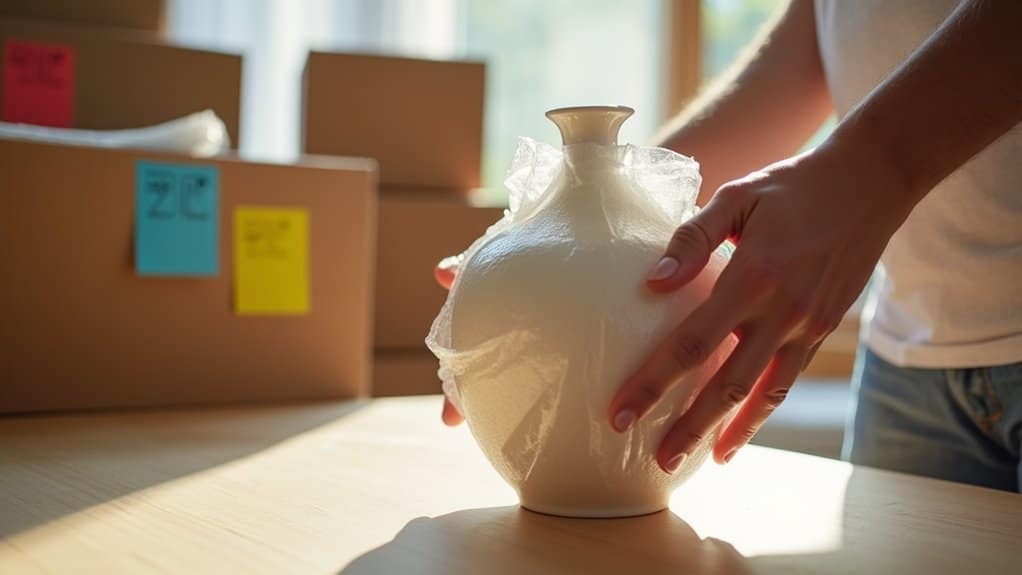
How to Handle Fragile Items During Domestic Removals
To handle fragile items during domestic removals, start by identifying your delicate belongings, such as glassware and ceramics. Make a detailed inventory and photograph each item for insurance purposes. Use high-quality packing materials like bubble wrap and crumpled paper to cushion each piece, and seal boxes securely, clearly marking them as "Fragile."
When loading, place heavier items in the van first, stacking fragile items on top, surrounded by soft materials for extra protection. If you're unsure, consider hiring professionals who specialise in moving fragile items. These simple steps can help ensure your cherished belongings arrive safely at your new home.
Key Takeaways
- Identify and assess fragile items, taking photographs and keeping receipts for insurance purposes to document their condition and value.
- Use quality packing materials, such as bubble wrap and packing peanuts, to cushion each fragile item securely.
- Clearly label all boxes as "Fragile" and stack them on top of sturdier items to avoid them being crushed during transport.
- Consider hiring professional moving services that specialise in delicate items, or opt for white glove services for high-value belongings.
- Keep detailed inventory records and photographs to support any insurance claims if damage occurs during the move.
Identifying Fragile Items
When moving, it's crucial to identify fragile items to ensure their safety during transit. Start by recognising characteristics of fragile items, such as materials that chip or break easily—think glassware, ceramics, and porcelain.
Small electronics, like tablets and smartphones, also need protection from physical damage and static electricity. Packing fragile items properly is essential to prevent damage during transport. Additionally, using cushioning paper can provide extra protection for these delicate objects.
When assessing an item's condition, look for signs of fragility. Heavy items with delicate parts, such as pianos, require special handling. Be mindful of sharp edges on picture frames or brittleness in vases.
Any irreplaceable or high-value item, like jewellery or antiques, needs extra care.
Furniture can also be fragile. Disassembling pieces or securing them with moving straps can help prevent damage.
Decorative items, like sculptures, and delicate clothing should be handled with care.
Evaluate each item's packing requirements, considering its weight, size, and construction. By thoroughly identifying your fragile items, you'll lay the groundwork for a smooth move.
Preparing an Inventory
When preparing an inventory of your fragile items, start by listing each piece and taking photographs to document their condition. Assess the value of each item for insurance purposes, as this will help safeguard your belongings during the move. Additionally, be sure to include a detailed list of all fragile items to ensure nothing is overlooked. Consider utilizing professional packing services to ensure your items are packed securely and organized systematically.
Identify Fragile Items
Begin by closely examining each room in your home to identify fragile items that need extra care during your move. Make a detailed inventory list that includes all delicate materials, such as glassware, ornaments, and electronics. It's essential to create an inventory list to ensure that no fragile item is overlooked during packing. Additionally, consider using sturdy boxes specifically designed for fragile items to provide extra protection.
Group similar items together to simplify your packing process and ensure nothing is overlooked. As you assess each item, note any pre-existing damage; this will guide you on how much attention they'll need during the move.
Remember to include larger specialty items like pianos, chandeliers, or antique furniture, as these require additional caution and possibly custom packing.
Categorise your inventory into specific sections: dinnerware, antiques, artwork, and musical instruments should all be included. For each fragile item, determine how it should be packed—some may need extra padding or bespoke crates.
Lastly, number each box containing fragile items and label it clearly, stating the contents and the room it belongs to. This organisation will make unpacking easier and help you keep track of your fragile belongings during the move.
Document With Photographs
Documenting fragile items with photographs gives you a reliable record of their condition before moving. Start by taking clear images from various angles to ensure detail is captured. Highlight any distinguishing features and pre-existing damage, and don't forget to photograph serial and model numbers for electronics. Good lighting is essential for clarity. Additionally, ensure you understand the vulnerabilities of each item type to capture any specific details that may need addressing during the packing process.
Alongside these photographs, organise your inventory list. Use a digital folder to store both the images and relevant item details. Cross-reference your inventory with the photos for accurate tracking, and ensure all images are timestamped to verify the condition before the move.
Organising by room or category makes it easier to find what you need later.
These photographs are vital for insurance claims, helping you assess damage and speed up the claims process. Timestamped images can also support any disputes over damage claims.
Assess Item Value
Assessing the value of your fragile items is crucial for ensuring they're well-protected during a move. Understanding the value of your belongings helps you arrange the right packing and insurance. Valuing household goods ensures peace of mind through proper valuation and insurance.
Here's how to begin:
- Original Value: Think about what you paid for each item.
- Current Market Value: Research similar items online or in local shops to determine their present worth.
- Condition: Evaluate the condition of each item, as this significantly impacts its value.
- Rarity: Identify if any items are rare or unique, which can enhance their value.
Compile your findings into a detailed inventory, noting the condition and any specifics that aid in accurate valuation.
For high-value items worth £500 or more, consider getting a professional appraisal to ensure the value reflects current demand and condition.
Regularly updating your inventory will help safeguard your investments during the moving process.
Documenting for Insurance
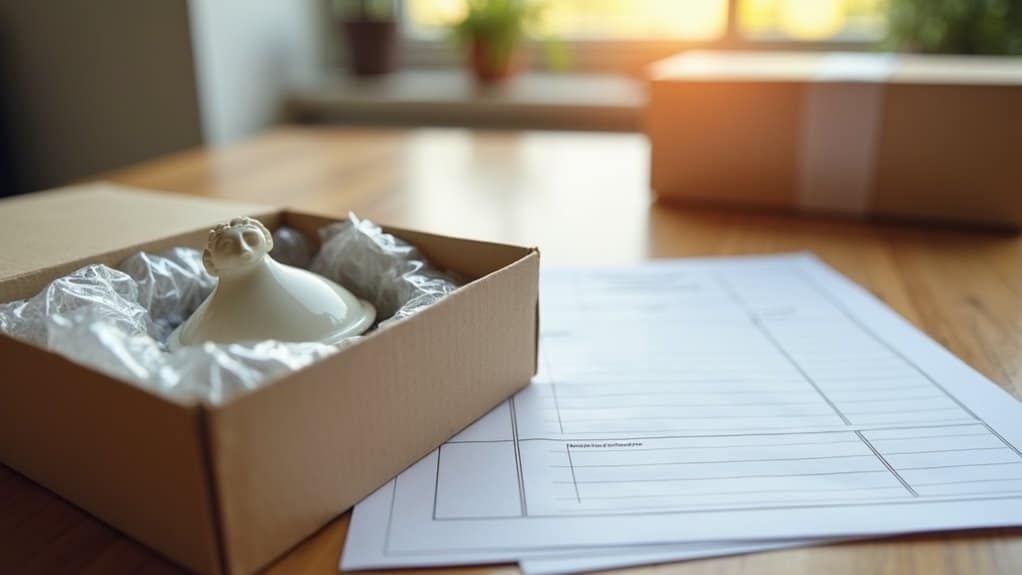
Documenting your fragile items is crucial for protecting your investment during a move.
By taking clear photographs and keeping detailed records, you can make the insurance claim process smoother should any damage occur.
For instance, if your prized porcelain vase gets chipped, having evidence of its condition beforehand will support your claim.
Understanding the significance of this documentation ensures you're prepared for any unexpected issues.
Importance of Documentation
Proper documentation is crucial for safeguarding your belongings during a house move. It not only helps maintain an accurate inventory but also protects your interests in the event of damage.
Here are some important aspects to consider:
- Detailed Inventory Lists: Compile comprehensive lists detailing the descriptions, conditions, and estimated values of your items. For example, clearly note if a sofa has a tear or if a painting is a valuable original.
- Condition Assessment: Record any existing damage before the move. This will clarify the item's state and help avoid disputes later.
- Evidence Collection: Keep receipts and appraisals to prove the value of your possessions. This is especially important for high-value items like antiques or electronics.
- Digital Storage: Save all documents digitally. This makes them easily accessible and adds an extra layer of protection against loss.
Taking Detailed Photographs
Capturing detailed photographs of your delicate items is crucial for accurate documentation and safeguarding your insurance claims. Use effective photography techniques, such as natural light to enhance details and a high-resolution camera for quality images.
Take shots from multiple angles to comprehensively document each item's condition, and don't forget to include any packaging materials.
Keep a photo log to ensure systematic documentation, noting each item's name and description alongside the images. Make sure each photograph has a date and time stamp for a clear timeline.
Consistency is important—use the same method for photographing all items to make comparisons easier later on.
Be sure to document any pre-existing damage and any special care instructions. Capture how items are packed, sealed, and labelled, as well as their arrangement within boxes.
After your move, take photos while unpacking to verify each item's condition against your pre-move documentation. This thorough approach not only highlights the importance of documentation but also strengthens your case should you need to make an insurance claim.
Insurance Claim Considerations
When filing an insurance claim for fragile items, thorough documentation is vital. Properly documenting your belongings can simplify the claims process and ensure you receive the coverage you're entitled to.
Here are four essential steps to follow:
- Create a Detailed Written Inventory: Before and after your move, list each fragile item, including descriptions, conditions, and estimated values. For example, if you have a glass vase, note its size, colour, and any existing flaws.
- Record Serial Numbers: For electronics or valuable items, jot down their serial numbers to help verify ownership and value. This is especially important for items like televisions or laptops.
- Gather Relevant Documents: Collect maintenance records, repair invoices, and receipts to support your claim. If you have had a piece of furniture restored, keep the receipt as proof of its value.
- Document Communication: Maintain a detailed log of all interactions with your insurance provider, including dates, times, and key points discussed. This can be useful if you need to refer back to previous conversations.
Following these steps can help ensure a smoother claims process for your delicate items.
Valuing High-Value Items
How can you ensure your high-value items are properly protected during a move?
Start by defining what high-value items are—typically anything worth over £1,000 or £100 per kilogram. Get an accurate appraisal to determine their worth.
Then, create an inventory using a high-value inventory form to keep track of these items and their condition throughout the move.
Take detailed photographs of your items before packing, as this documentation is crucial for any potential insurance claims.
Clearly label all boxes containing high-value items to ensure they're handled with care by the removal team.
When packing, use sturdy materials like double-walled boxes and bubble wrap for added protection.
It's wise to hire movers who are experienced in handling high-value items for extra peace of mind.
Finally, inspect your items thoroughly upon delivery to spot any damage straight away.
Following these steps will help safeguard your prized possessions during the move, reducing the risk of losses or damages.
Disassembling Large Furniture
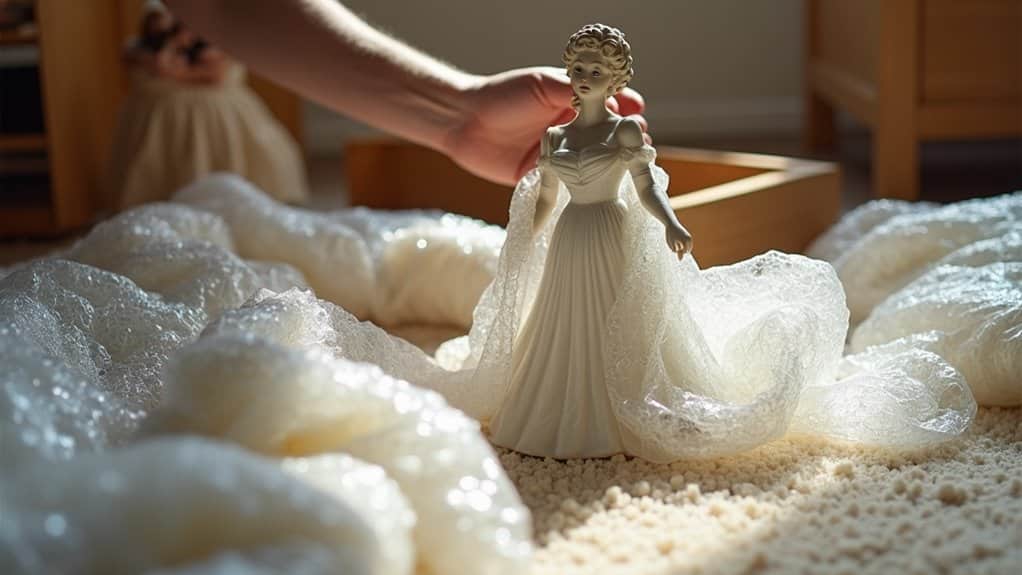
Disassembling large furniture may seem daunting, but with a clear plan, you can simplify the task. Here's how to make the process smoother:
- Measure: Check the dimensions of your furniture and the spaces it needs to pass through, including doorways and corridors.
- Empty: Clear out all items from drawers and shelves to prevent damage and facilitate disassembly.
- Gather Tools: Get the necessary tools, such as screwdrivers and spanners, to help you disassemble efficiently.
- Label Parts: As you take things apart, label each component and keep small hardware in labelled containers.
For delicate items like mirrors or glass shelves, wrap them in blankets or bubble wrap to keep them safe.
Start by removing any detachable pieces first, like cushions and shelves, to make disassembly even easier.
Cushioning Techniques
Effective cushioning is vital for safeguarding fragile items during your move. Start by creating a cushioned base in your boxes using crumpled packing paper or packing peanuts. This layer absorbs shocks and stops items from shifting.
Wrap each delicate item individually in bubble wrap or foam sheets to provide snug protection. Fill any gaps between items with packing peanuts or extra crumpled paper to prevent movement during transit.
Add a top layer of cushioning materials, like air pillows or more packing paper, for added protection before sealing the box. For exceptionally fragile items, consider using foam inserts or custom crates.
To check your packing, gently shake the box—if you hear or feel movement, reassess your cushioning methods. Reinforce seams with additional packing tape and secure boxes with straps to keep everything in place.
Finally, set up a clear unpacking area with a soft surface to handle your fragile items safely when you arrive at your new home. By using these effective cushioning techniques, you can significantly reduce the risk of damage during your move.
Effective Wrapping Methods
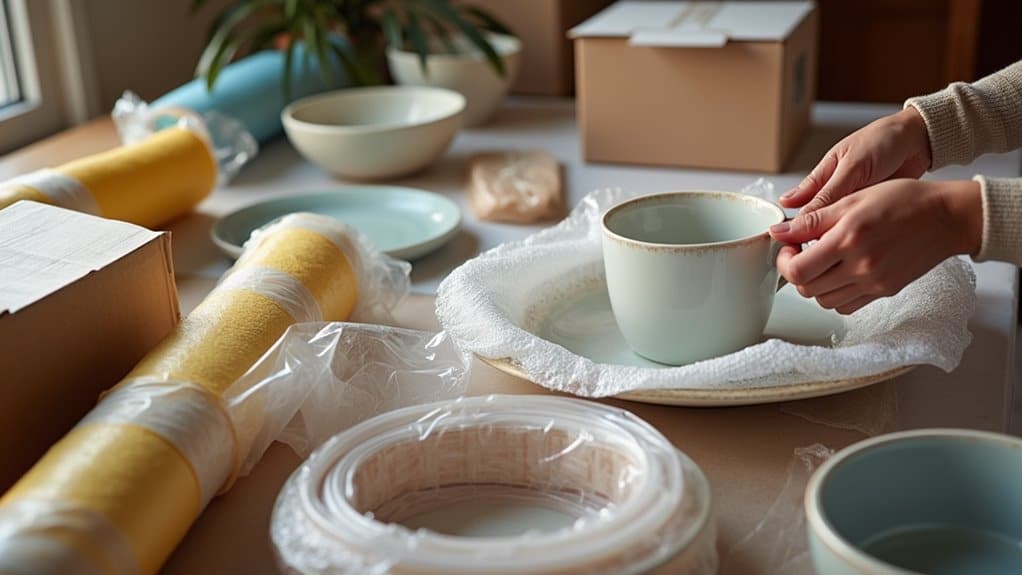
When wrapping fragile items, using the right materials is crucial for protection.
It's important to layer your wrapping to create a cushion against impacts, ensuring your items stay safe during transport.
For example, bubble wrap is excellent for delicate glassware, while cardboard boxes provide sturdy support.
Selecting Appropriate Materials
Choosing the right materials for wrapping fragile items during a home move is crucial for ensuring their safety. Effective packing techniques and cushioning can significantly lower the risk of damage.
Here are some materials to consider:
- Bubble Wrap: This provides a protective layer that absorbs shocks and keeps items safe from direct contact with the outer packaging.
- Foam Sheets: These are perfect for wrapping delicate items, offering soft cushioning and protection against impacts.
- Packing Peanuts: Lightweight foam peanuts fill empty spaces in boxes, reducing movement and adding cushioning during the journey.
- Crumpled Paper: An economical choice for filling voids, it provides additional support and cushioning.
Don't forget to select sturdy outer packaging, such as corrugated cardboard boxes, which can withstand external impacts.
Reinforced corners and double-walled boxes offer extra protection for your fragile belongings.
Layering for Extra Protection
Layering for extra protection is crucial when moving fragile items.
Begin with a solid base layer by placing crumpled packing paper or packing peanuts at the bottom of the box. This cushion absorbs shocks and stabilises the contents.
Next, wrap each item individually with bubble wrap or foam sheets, ensuring you cover all sides, including corners and edges, for a snug fit. Use tape to secure the wrapping.
For extremely delicate items, add extra cushioning with additional layers of bubble wrap or foam. Fill hollow spaces in vases or jars with packing paper to reduce vibrations.
After packing, gently shake the box; if items shift, they need more padding.
Always place heavier items at the bottom of the box and leave space between items to prevent contact. Filling gaps with packing material enhances protection.
Finally, seal the box securely and label it as "Fragile" for careful handling. These layering techniques will significantly reduce the risk of damage during transit.
Securing Boxes Properly
To secure boxes properly for fragile items, begin with sturdy, high-quality boxes that can withstand the demands of moving.
Choosing the right materials is crucial for effective packing. Here's how to ensure your fragile items are well protected:
- Line the Bottom: Use packing peanuts, crumpled paper, or bubble wrap to cushion the base of each box.
- Distribute Weight: Place heavier items at the bottom to maintain stability and prevent lighter items from being crushed.
- Avoid Overpacking: Don't overload boxes. Leaving a bit of space helps prevent damage and improves stability during transit.
- Seal Securely: Use strong packing tape to seal boxes, ensuring they won't open or collapse while being moved.
Choosing Quality Packing Materials
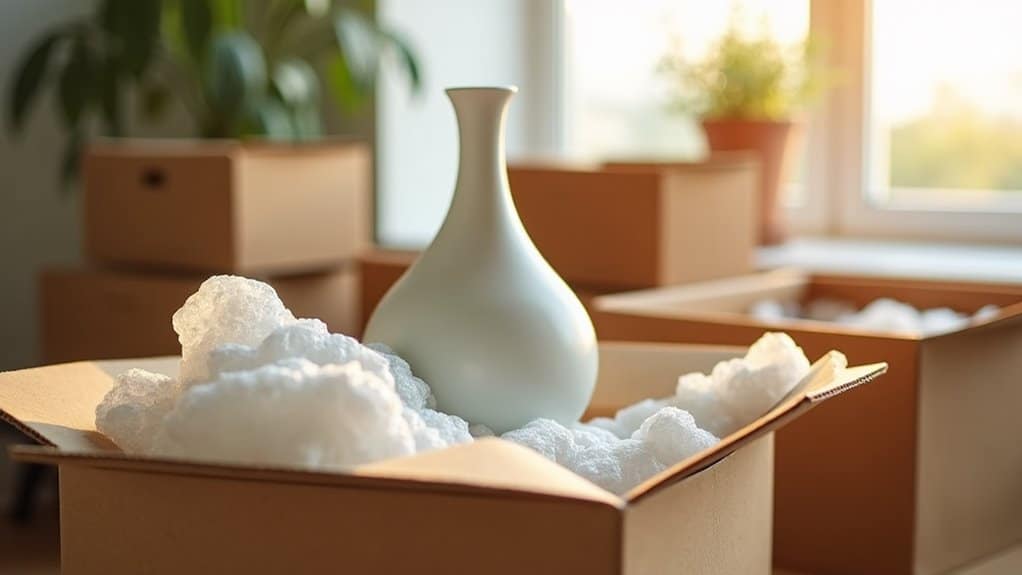
Choosing quality packing materials is crucial for protecting your fragile items during a move. Start with high-quality bubble wrap, which effectively cushions against shocks and vibrations.
For less delicate items, packing paper offers basic protection. For particularly fragile or uniquely shaped items, consider specialised packaging like foam inserts or custom-fitted polystyrene.
To fill gaps in boxes and prevent movement, use biodegradable packing peanuts or crumpled packing paper. When packing electronics, anti-static bubble wrap is essential to guard against electrical charges.
Always choose sturdy corrugated cardboard boxes, as they absorb shocks and withstand the rigours of transit.
Avoid reusing old boxes, as their strength may have diminished. If you're eco-conscious, seek out sustainable materials that still provide sufficient protection.
Don't forget to label all boxes clearly as "Fragile" or "Handle with Care," and use strong tape to seal them securely.
Packing Order Considerations
When packing fragile items, getting the order right is crucial for their safety during transit.
Here's how to layer your items effectively:
- Start with cushioning: Begin with a layer of packing peanuts or crumpled paper at the bottom of the box.
- Place heavier items first: Position heavier items at the bottom to ensure stability and avoid crushing lighter, more delicate items.
- Add fragile items: Place your fragile items in the centre of the box, surrounded by plenty of cushioning on all sides.
- Fill gaps: Use extra packing peanuts or crumpled paper to fill any empty spaces, preventing movement during transport.
Labeling for Easy Identification
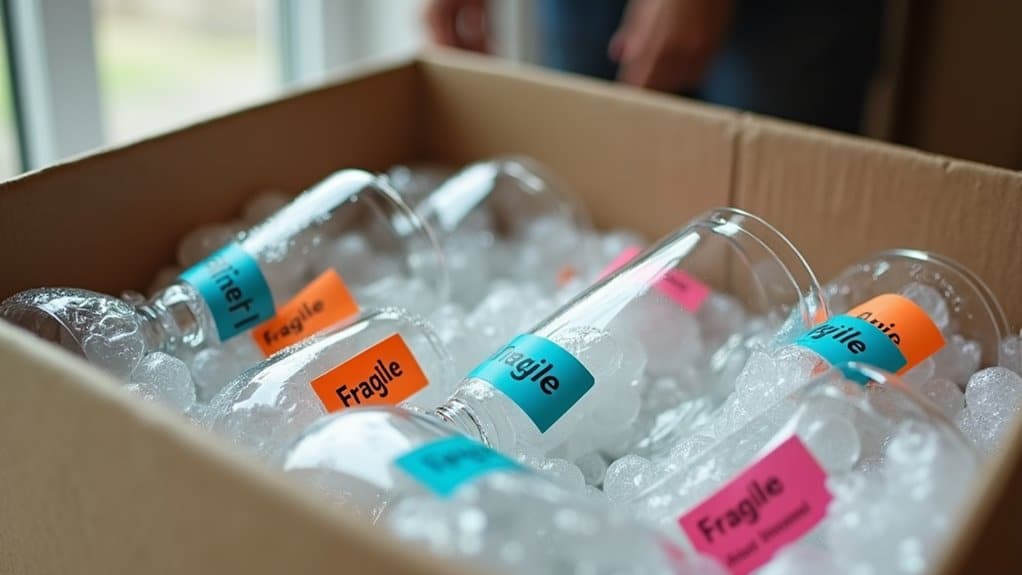
Proper labelling is crucial for ensuring fragile items are treated with care during a move. Start by using bold, clear fonts for your labels to enhance visibility. Place labels on multiple sides of each box so that anyone handling them can easily identify their contents. Always include clear indications like "Fragile" or "Handle with Care," and consider using bright colours or symbols to attract attention.
Be specific with your labelling. Phrases such as "Glass Inside" or "Electronics" help movers know what they're dealing with. Use directional arrows to show the correct orientation, and remember to label the top, sides, and bottom of boxes.
For particularly delicate items, like antiques, use detailed labels that highlight their uniqueness or any pre-existing damage.
Finally, ensure your labels are durable by selecting high-quality materials that won't come off during transit. Always check your labels before shipping to make sure they're securely attached.
Keeping a record of labelled boxes can help with tracking, and communicate your labelling practices with movers to ensure everyone is on the same page. This approach minimises the risk of damage to your fragile items during the move.
Strategies for Loading
When loading your van, the order in which you stack items is crucial for protecting fragile belongings.
Start with heavier items at the bottom to create a stable base, then secure lighter items on top.
For example, place your sofa first, followed by boxes of books, and finish with delicate items like glassware.
This method helps ensure your fragile items arrive safely at your new home.
Loading Order Importance
Understanding the loading order is crucial for a successful house move, particularly when it comes to safeguarding fragile items during transit. Proper loading techniques can significantly enhance the likelihood of your delicate belongings reaching their destination intact.
Here are four key strategies to keep in mind when loading:
- Load Large Items First: Begin with bulky furniture and appliances to create a stable foundation.
- First-In, Last-Out: Place fragile items at the back of the vehicle, so they're the first to be unloaded. This reduces handling time and the risk of damage.
- Top Placement: Stack fragile boxes on top of sturdier items to prevent them from being crushed during the journey.
- Buffer Zones: Surround fragile items with soft materials like blankets or clothing to cushion them against jolts and bumps.
These straightforward steps can help ensure your precious items arrive safely at your new home.
Secure Placement Techniques
Securing fragile items during loading is crucial to ensure they arrive at your new home intact. Start by placing fragile items in areas of the van where movement is minimal. Position boxes centrally to protect them from sudden stops and turns, and surround them with softer items for added cushioning. Distributing weight evenly on both sides of the vehicle helps prevent tipping.
Maximise stability by placing heavier boxes beneath lighter, more fragile ones. Avoid stacking fragile items on top of each other, and use straps or tie-downs to secure boxes and prevent movement. Fill any gaps with packing peanuts, foam, or crumpled paper to minimise shifting during transport.
Cushion your fragile items with thick layers of packing peanuts or bubble wrap for extra protection. Moving mats can prevent scratches during loading and unloading.
Handling Large Fragile Items

Moving large fragile items poses several challenges, but with proper planning, you can ensure their safety.
Here are some essential steps to protect your valuable belongings during the move:
1. Create an inventory: List all large fragile items. This helps you keep track of them throughout the moving process.
2. Use specialised packing materials****: Invest in quality packing supplies, such as bubble wrap and sturdy boxes, to safeguard your items.
Custom crates may also be worth considering for particularly delicate pieces.
3. Disassemble if possible: Take apart larger items, like furniture, to make them easier to handle and reduce the risk of damage.
4. Label clearly: Mark boxes and items as "Fragile" so that everyone involved understands the need for careful handling.
Utilizing Professional Services
When moving fragile items, hiring professional services can significantly improve both safety and efficiency. These services offer tailored moving plans that cater to your specific requirements and budget, ensuring your delicate belongings receive proper care.
Experienced professionals know how to handle fragile items and use high-quality packing materials to reduce the chances of breakage.
You can opt for fragile-only packing services for select items or full-service moving companies that offer comprehensive solutions. White glove moving services are particularly suited for high-value items, providing exceptional care throughout the entire process.
Moreover, reputable moving companies often include fragile item insurance, giving you peace of mind against any accidental damage during transit.
They also ensure precise tracking and handling with detailed inventory and labelling processes.
Tips for Safe Transport
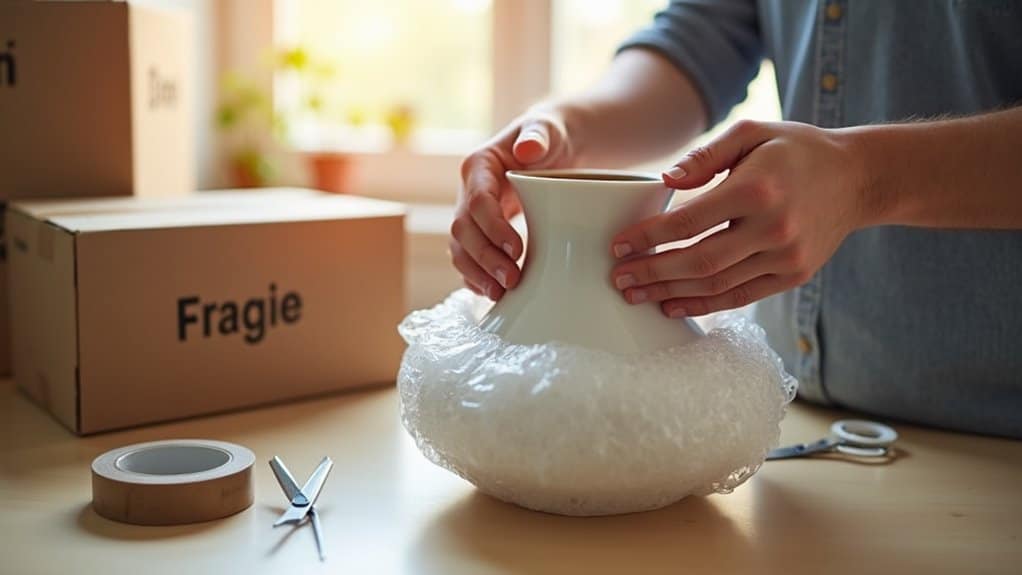
Ensuring the safe transport of fragile items requires careful planning and execution. By using effective packing methods and following safety measures, you can significantly reduce the risk of damage during your move. Here are some essential tips:
- Use quality packing materials: Materials like bubble wrap and foam sheets provide necessary cushioning for fragile items.
- Wrap items individually: Ensure each piece, such as plates and glassware, is wrapped separately to avoid breakage.
- Fill empty spaces: Use packing peanuts or crumpled paper to fill gaps in boxes, preventing items from shifting during transit.
- Load with care: Place heavier items at the bottom of the moving vehicle and secure fragile boxes in safe spots to minimise movement.
When driving, take care to avoid sudden stops or sharp turns. Opt for smoother routes to maintain stability, and regularly check your securing straps to ensure everything stays in place.
Keeping fragile items away from doors will further enhance safety. By following these straightforward tips, you'll greatly reduce the chances of damaging your delicate belongings during your move.
Frequently Asked Questions
What Types of Insurance Cover Fragile Items During a Move?
When moving fragile items, you have two main insurance options: Released Value Protection and Full Value Protection. These cover your delicate belongings during the move, but you might want to consider additional premiums for more comprehensive protection. For example, if you're moving expensive glassware or artwork, investing in extra coverage could save you from costly damages.
How Can I Assess the Value of My Fragile Items?
To assess the value of your fragile items, consider both their condition and sentimental value. Start by documenting each item's state—take clear photos and note any wear or damage. Next, set realistic monetary values based on how much similar items sell for or what it would cost to replace them. For example, if you have a vintage vase, check online marketplaces to see what similar ones are going for. This thorough approach will give you a clearer picture of their worth.
Should I Use My Own Boxes or Buy New Ones for Fragile Items?
When packing fragile items, think about the type of boxes you use. While using your own boxes can save you money, purchasing new ones often ensures better strength and protection. For instance, a sturdy new box is less likely to collapse than an old, worn-out one. Prioritise durability to keep your fragile belongings safe during transport.
How Do I Find Professional Movers Experienced With Fragile Items?
To find professional movers experienced with fragile items, start by researching moving advice and reading customer reviews. Ask about their packing methods and confirm that they specialise in delicate items. Look for a company with a strong reputation for careful handling, such as those that use custom packing materials or have experience with antiques and glassware.
What Should I Do if a Fragile Item Gets Damaged During the Move?
If a fragile item is damaged during your move, take clear photos of the damage, notify the moving company straight away, and follow their claims process. For future moves, prioritise damage prevention by using high-quality packing materials and considering professional packing services. For example, bubble wrap and sturdy boxes can make a significant difference in protecting your valuables.
Conclusion
When it comes to fragile items, a bit of caution can make all the difference. You can risk it and hope everything arrives in one piece, or you can follow these effective strategies. By preparing properly, taking inventory, and enlisting professional help, you can ensure your precious belongings stay safe. Don't let carelessness derail your careful planning; instead, enjoy the peace of mind that comes from knowing you've taken all the necessary steps to protect your delicate items during your move.


